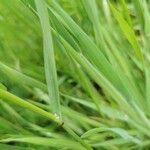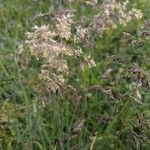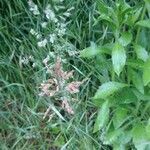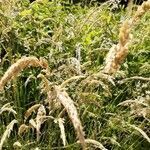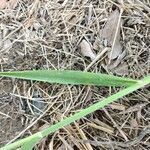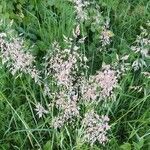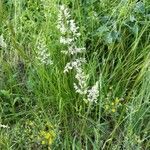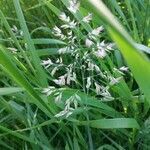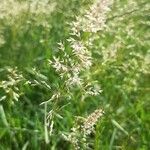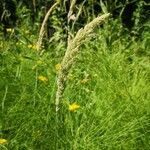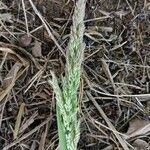Perennial, caespitose, erect or geniculate. Culms 20–100 cm high. Young shoots extravaginal. Leaves mostly basal; basal sheaths puberulous and pilose, with hairs of two distinct lengths (shorter hairs c. 0.1. mm long and long hairs to 1 mm long); ligule truncate, dentate, abaxially hairy; blade 4–15 cm long, 3–10 mm wide, puberulous and pilose (with hairs of two distinct lengths). Panicles 2.5–27 cm long; primary branches scabrous and shortly pilose (with hairs of two lengths, the longer to 0.4 mm long, straight). Spikelets 3.7–5.2 mm long. Glumes: lower glume 3.4–4.4 mm long, muticous or apiculate, with midnerve scaberulous and shortly pilose with longer hairs toward apex; upper glume 3.7–5 mm long, obtuse, apiculate (midrib very shortly extended, to 0.4 mm long). Lemma ovate, 2–2.5 mm long, acute, keeled in upper half, 5-nerved; callus with 4 rigid hairs c. 1.3 mm long. Upper floret male; callus with short hairs c. 0.3 mm long; lemma 1.1–2 mm long, keeled at apex; lemma awn c. 1 mm long, arising in upper 1/4 of lemma, with column usually not twisted, uncinate or curved.
Perennial, softly hairy. Culms tufted, erect or geniculate at base, 30–80 cm tall, pubescent, 4–5-noded. Leaf sheaths loose, tomentose with reflexed hairs; leaf blades flat, 6–18 cm, 3–9 mm wide, soft, both surfaces pubescent, apex acute; ligule 2–3 mm, truncate or toothed. Panicle lanceolate to oblong or ovate in outline, rather loose to very dense, 3–12 cm; branches narrowly ascending, pubescent. Spikelets oblong or gaping, 3.5–6 mm, pale grayish green or purplish; glumes lanceolate, keel and veins hispidulous, surface scabrid or puberulent to villous, lower glume apex acute, upper glume wider and sometimes slightly longer than lower glume, apex mucronate; florets subequal, 2–2.5 mm; rachilla ca. 0.5 mm; lower lemma awnless, anthers 1.8–2 mm; upper lemma with hooked 1–2 mm awn, anthers ca. 1.5 mm. Fl. and fr. May–Oct.
Loosely tufted perennial, 0.3-1.0 m high; culm nodes pubescent. Leaf blade 1.5-8.0 mm wide; conspicuously woolly-hairy, greyish to blue-green; ligule an unfringed to a fringed membrane. Inflorescence a contracted, often dense panicle. Spikelets 3-4 mm long, laterally compressed; glumes ± equal, ± as long as spikelet, keeled, 1-3-nerved; lower glume awn up to 0.5 mm long, rarely up to 1 mm; upper glume awn up to 1 mm long. Florets 2; lower floret bisexual, firmer than glumes, awnless; upper floret male, lemma awned from back near apex; awn short, stout, hooked, geniculate, twisted or straight, barely projecting beyond apices of glumes; anther 1.0-1.5 mm long. Flowering time Nov.-Jan.
Culms 4–10 dm, without rhizomes, soft-villous below, the upper internode usually glabrous; sheaths soft-hairy; blades pale green, soft-hairy, 4–10 mm wide; infl narrowly ovoid, dense, 5–15 cm; glumes 4–5 mm, acute, villous on the surface, short-hirsute on the veins; lemmas smooth and shining, 2 mm, obtuse, the awn of the upper one hooked, 1–2 mm, scarcely exserted from the glumes; 2n=14. Meadows and roadsides in moist soil; native of Europe, now well established throughout our range.
Loosely tufted perennial 300-1000 mm high; culm nodes pubescent. Leaf blade 1.5-8.0 mm wide; conspicuously woolly hairy, greyish to blue-green. Inflorescence whitish, green pink or purple. Spikelet 3-4(6) mm long; lower glume awn to 0.5 mm long, rarely to 1 mm, 1-nerved; upper glume awn to 2 mm long; upper floret male; upper lemma awn hooked, barely projecting beyond apices of glumes; anther 1.0-1.5 mm long.
Perennial, loosely tufted, up to 1 m high. Leaf blades 1.5-8.0 mm wide. Leaves conspicuously woolly, greyish to blue-green. Spikelets 3-4 mm long; lower glume awn never exceeding 0.5 mm; upper glume awn to 1 mm long; upper floret male.
Perennial to 1 m. Leaves linear-lanceolate, softly hairy. Spikelets in a panicle, pink and grey, upper glume awn to 1 mm.

